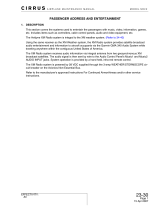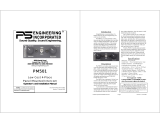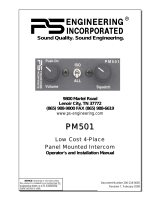
200-196-0104 Page 4 April 2020 Rev. 13
2.3.5 Remote Configuration (11961)
The PM1200-Remote is designed for blind mounting.
The unit can be controlled through two remote potentiome-
ters for volume and two SPDT switches. Mount the volume
controls in a location accessible to the pilot and copilot, and
the VOX and ISO switches convenient to the pilot in com-
mand position. The pilot’s volume pot also contains an on-
off switch. See page 7 for wiring information.
NOTE: Due to the exposed signal paths for the volume con-
trols, these installations are more prone to electrical noise,
and extreme care must be taken in constructing the harness,
with wire runs as short as possible. PS Engineering does
not guarantee a noise-free installation in this configuration.
This version cannot be expanded.
2.3.6 Expansion Configuration (11960-EXP)
The PM1200-EXP is configured internally to add ex-
pansion capability for more than two positions. Using an
IntelliPAX expansion unit, part number 11616, an addition-
al 6 intercom positions can be available.
Although not marked, the lower position on the ISO/
ALL switch becomes a “Crew” position.
NOTE: The IntelliPAX includes IntelliVOX intercom, but is
not specifically designed for high noise environment. It may
be desirable to have an intercom P-T-T, by installing an in-
line, momentary normally open switch on the mic audio
lines, or use a portable intercom P-T-T that have an open
mic audio switch contact.
2.4 Post installation checkout
After wiring is complete, verify power is ONLY on pin
14 of the connector, and airframe ground on pin 1. Failure
to do so will cause internal damage and void PS Engineer-
ing's warranty.
1. Apply power to the aircraft and avionics.
2. Plug headsets into the pilot and copilot positions.
3. Verify that the pilot position can transmit and receive.
With the PM1200 in the OFF position (press the pi-
lot’s volume control knob to turn off).
4. Turn the unit on and rotate the pilot volume clockwise,
about half way. Verify that the Pwr/Xmt light comes
on, and shows green. If the LED is red, stop testing
and trouble-shoot the microphone PTT installation.
5. Verify that the pilot can transmit and receive on the
com transceivers.
6. Verify that the LED in the intercom changes from
green to red when a radio PTT is pressed.
7. Verify proper intercom operation for pilot and copilot.
For more information, consult Section 3.
8. Verify proper transmit and receive operation on the
copilot position, noting that the copilot PTT switch
allows proper transmission on the selected transceiver.
9. Verify proper Intercom system operation in the ALL and
ISO modes.
10. Verify that the intercom system does not adversely affect
any other aircraft system by systematically switching the
unit on and off, while monitoring the other avionics and
electrical equipment on the aircraft.
11. PTT ICS– Push the copilot volume control to activate the
PTT-ICS mode. Verify that the mic audio is heard when the
signals can be a factor when low level mic signals are bun-
dled with current carrying power wires. Keep these cables
separated.
Insulating washers are required on all mic and head-
phone jacks to isolate them from aircraft ground. The use of
a conductor instead of a shield for ground return eliminates
these ground loop paths.
2.3.2 Power Requirements
The PM1200 was designed to work with either 12 or 28
volt DC negative ground systems. The PM1200 must be
externally protected with a one ampere (1A) circuit breaker
or fuse.
2.3.3 PTT-ICS
The PM1200 is designed for noisy installations, such as
open cockpit aircraft. In addition to the Advanced Micro-
phone Processing (AMP) and IntelliVOX® squelch, the unit
includes a VOX/PTT-ICS mode, controlled by the pushing
the copilot volume knob. In this mode, no pilot mic audio is
passed to the intercom unless pin 2 is connected to 16, or
copilot mic audio unless pin 15 is connected to pin 2
through a normally-open, momentary switch (not supplied).
2.3.4 Music Input
Entertainment devices can be connected to the
PM1200. Install a 1/8" jack convenient the pilot to connect
the entertainment device into the system. Since the PM1200
is monaural, you may want to connect the left and right
channels together at the music jack. Depending on the mu-
sic source used, 10Ω resistors in series with the left and
right channels may be desireable to avoid loading and
possibly damaging the source.
A "Soft Mute" system is installed in the PM1200 that
will mute the music during intercom or radio activity.
WARNING: Local oscillators and other internal sig-
nals from CD or radio equipment can cause undesired inter-
ference with VHF navigation and communication equip-
ment. Before takeoff, operate the entertainment device to
determine if there is any adverse effect on aircraft systems.
If any unusual operation is noted in flight, immediately
switch the entertainment device off.
If the PM1200 is used with an expansion unit, music
connected to the PM1200 will be heard in the panel unit and
expansion unit in ALL intercom mode. Music connected to
the expansion unit will only be heard by passengers in Crew
mode. Connect music source to BOTH units to distribute
the same music in both units.
NOTE: Auxiliary microphone and headset jacks are
required for a complete installation. These aid in trouble-
shooting and a back-up access to the aircraft radios.
Note: Use the low level (or line) output from
any music device to connect to the PM1200.
Maximum input level is 2 V peak-to-peak.
DO NOT USE SPEAKER OUTPUT.
These levels will cause internal damage.











